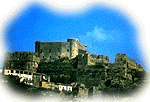ISOLA CAPO RIZZUTO
Of ancient origin, rebuilt in the neiboroughs of a Benedictine Monastery, it was Bishp's See and more than once it was raided by the Turks in XVI century. Old Burg Door and next to it St.Marco's Church (XVI century). Renaissance Cathedral (XVII century Portal). Ruins of the Castle of the Ricca (XVI century) and of the circuit of the walls. In locality Capo Rizzuto, Angevin Tower (XVI century) and "Fortino" Tower (XVI-XVII centuries). In the homonymous locality, Le Castella's fortified Burg with Greek tracks (Seaside Walls), Angevin Tower (XIII century) and donjon of the sixteenth century, built by Conte Andrea Carafa.
CROPANI
Dark Ages Nucleus, it had the old honour of Venice Citizenship after offering some help to the sailors carrying St.Marco's body to Venice from Alessandria. Old Portal and Colleggiata Church of Our Lady of the Assumption (Portale durazzesco of the sixteenth century).
BELCASTRO
Old Bishop's See, in 1644 a terrible earthquake destroyed the built up area, the walls and 70 of its Churches. St. Michael Archangel's Cathedral (rebuilt in 1692). Castle of the Conti d'Aquino (XIII-XV centuries); Poerio Palace (XVIII century). Ruins of S.Francesco's Church and of the Church of Our Lady of the Annuciation. (XVII century) Pity's Church (XV century). "Chiesetta di San Rocco" (XVII century Portal). Ruins of the Crocchio's tower. (XVI century).
STRONGOLI
People say that ancient Macalla once rose in Strongoli's present territory and that it was, maybe, the place where Petelia (which owing to its faithfulness to Rome was destroyed during the second Punic War) rose. It was a Bishop's See. Roman Ruins in Murge, Fasanello, located. Old graveyard. Castle and Treasure Stone (Pietra del Tesauro). Inscription on stone slab (Nerva-Traiano's Epoch) at the basement of the civic Clock-Tower. Church of S. Maria delle Grazie (XVII century) St.Peter and Paul's Church (XVIII century). Norman castle (XII century) rebuilt in the fourteenth an eighteenth centuries. Bishop's see (of communal property nowadays). Limera Tower (XVI).
CIRO' MARINA
The ruins of Apollo's Greek temple testify the existence of the ancient Cremissa, one of the Graecia Magna's towns. The Temple dates to the fifth century b.C.. In Madonna di Mare locality, Punta Alice Tower (XVI century) and Saracen Markets, in ancient times used for the Autumn Rite of Itria. Prince's Castle, now Sabatini Palace (XVI century).
CIRO'
In ancient times Zirò and Ipsycrò, in the Middle Ages it was a Bishop's See. Ruins of the circuit of the walls and of the castle (XV-XVI century). Sanctuary of Maria SS. d'Itria.
S.GIOVANNI IN FIORE
It rose in the seventeenth century round the "Abbazia Florense", See of the monastic order of the Florensi, order founded by the Abbot Gioacchino da Fiore in 1189. Abbatial Church with one naive and three aspes. Backing with three ogival windows with one opening surmounted by a hexalobate rose, in its turn surrounded by three smaller quadrilobate roses. In the facade, ogive arches Portal. Inside wood chor of the seventeenth century, St.John the Baptist's statue, baroque altar of the eighteenth century. Cathedral (XVI century portals). Our Lady of Annunciation's Church (XVII century).
MELISSA
Ruins of the Middle Ages Castle (XIII century) in locality Torre Melissa, Coast Small Fortress (XVI century).
CRUCOLI
Ruins of the Norman Castle which was rebuilt in the sixteenth and eighteenth centuries.
PALLAGORIO
Church of Mount Carmel.
CACCURI
The old burg reveals medieval elements. Castle of the Barons Barracco (XIX century remakings) and feudal Chapel. St. Mary's Church and Reformed's Church (XVI-XVII centuries).
SANTA SEVERINA
The old Syberene, Bishop's See since the tenth century, it was one of the most important Byzantine markets in Calabria. Occupied by the Saracens in 866, royal city under the Normans, it was feud of the Ruffo, the Carafa, the Sculco and the Grutter. Our advide to you is that of getting into this small town on foot, through the ancient medieval entry, which leads to the square called Largo del Campo. St. Anastasia's Metropolitan Basilica, (XIII century), Byzantin Baptistry (VII-IX centuries). Our Lady of Sorrow's Church (XVII century), built on the ruins of St. Anastasia's ancient Cathedral (X century). Of byzantin-roman origin the Hospital's Church and on two plains, St. Filomena's and St.Maria del Pozzo's Churches Archbishop's Palace (XIV century). Ex seminary (XVII century) Campitelli's House (XV-XVI centuries). Carafa's Castle (XVI century).
CARIATI
Bishp's See since 498, in 1544 it was raided by the Turks who deported part of the population. Circuit of the walls (XV-XVI centuries) and entry to the enclosed burgo. River Nicà's tower (ruins). To the fifteenth century dates back the Church of the Franciscan friars and St. Michael Archangel's Cathedral rebuilt in 1857. St. Filomena's Church (XV century). St. Peter Venneri's Tower (XVII century).
CERENZIA
In locality Paparotta suggestive built-up area of the ancient Acerenthia (IX century), abandoned in XIX century. Ruins of the built-up area, of St. Theodor's Cathedral and of the fortifiation.
ROCCABERNARDA
Ruins of the Cloister of St.Francesco dei Paolotti and of the Swabian Castle.
ALTILIA
Calabro Maria's Basilian Monastery and Barracco Palace.
CUTRO
"Reformed's Church", where a Crucifix, maybe a work of the Friar Umile da Pietralia's is housed.
PETILIA POLICASTRO
Santa Spina's Sanctuary, (XVI century), where a spine of Christ's crown's is looked after.
APT
TOURIST BOARD OF CROTONE
Via Torino, 148 - 88074 Crotone
Tel. ++39-962-23185 - Fax. ++39-962-26700
E mail:crotone@fromitaly.it |
|






